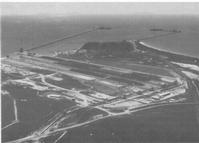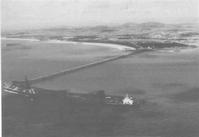


Chapter 6
I Construction During The Settlement Years
II The Use Of Timber As A Structural Material
III Structural Steel
IV Concrete Technology
V Housing
VI Industrialised Pre-cast Concrete Housing
VII Ports And Harbours
i Containerisation
ii Mineral Ports
iii Oil and Gas Ports
iv Other Bulk Cargoes
v Dredging
VIII Roads
IX Heavy Foundations
X Bridges
XI Sewerage
XII Water Engineering
XIII Railways
XIV Major Buildings
XV Airports
XVI Thermal Power Stations
XVII Materials Handling
XVIII Oil Industry
XIX The Snowy Mountains Scheme
XX The Sydney Opera House
XXI The Sydney Harbour Bridge
XXII Hamersley Iron
XXIII North West Shelf
Sources and References
Index
Search
Help
Contact us

Mineral Ports
The growth of Australian mineral exports during the past ten to fifteen years has also changed the nature of some existing ports and necessitated the construction of many new special purpose ports around the coastline. Offshore coal loading facilities, such as in Queensland at Hay Point and Abbot Point, have introduced new concepts of design, construction and materials handling techniques. Further, iron ore export ports in Western Australia, such as Dampier, Port Hedland, Port Walcott, bauxite at Weipa and Gove as well as coal loading facilities at Newcastle and Port Kembla, have required, in many cases, innovative design and construction techniques in the provision of the facilities.Typical examples of offshore coal loading facilities are those at Hay Point as shown in Fig. 19. The Dalrymple Bay Terminal on the left of the photograph has an annual capacity of 15 million tonnes, a maximum ship loading rate of 6,600 tonnes per hour and the berth can accommodate ships up to 200,000 d.w.t.

The other terminal is Utah No. 1 and No. 2 Berths (Fig. 20). The capacity of these berths is 11 million and 14 million tonnes per annum respectively.

People in Bright Sparcs - Wallace, J. M.
 |
Australian Academy of Technological Sciences and Engineering |  |
© 1988 Print Edition pages 340 - 341, Online Edition 2000
Published by Australian Science and Technology Heritage Centre, using the Web Academic Resource Publisher
http://www.austehc.unimelb.edu.au/tia/342.html